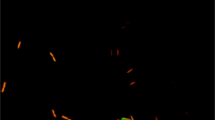Abstract
Fluorescent in situ hybridization (FISH) on environmental samples has become a standard technique to identify and enumerate microbial populations. However, visualization and quantification of cells in environmental samples with complex matrices is often challenging to impossible, and downstream protocols might also require the absence of organic and inorganic particles for analysis. Therefore, quite often microbial cells have to be detached and extracted from the sample matrix prior to use in FISH. Here, details are given for a routine protocol to extract intact microbial cells from environmental samples using density gradient centrifugation. This protocol is suitable and adaptable for a wide range of environmental samples.
Access this chapter
Tax calculation will be finalised at checkout
Purchases are for personal use only
Similar content being viewed by others
References
Almeida C, Azevedo NF, Santos S et al (2011) Discriminating multi-species populations in biofilms with peptide nucleic acid fluorescence in situ hybridization (PNA FISH). PLoS One 6:e14786
Lukumbuzya M, Schmid M, Pjevac P, Daims H (2019) A multicolor fluorescence in situ hybridization approach using an extended set of fluorophores to visualize microorganisms. Front Microbiol 10:1383
Schmidt H, Eickhorst T (2013) Detection and quantification of native microbial populations on soil-grown rice roots by catalyzed reporter deposition-fluorescence in situ hybridization. FEMS Microbiol Ecol 87:390–402
Cardinale M (2014) Scanning a microhabitat: plant-microbe interactions revealed by confocal laser microscopy. Front Microbiol 5:94
Thimm T, Tebbe CC (2003) Protocol for rapid fluorescence in situ hybridization of bacteria in cryosections of microarthropods. Appl Environ Microbiol 69:2875–2878
Pernthaler A, Amann R (2004) Simultaneous fluorescence in situ hybridization of mRNA and rRNA in environmental bacteria. Appl Environ Microbiol 70:5426–5433
Yilmaz S, Haroon MF, Rabkin BA et al (2010) Fixation-free fluorescence in situ hybridization for targeted enrichment of microbial populations. ISME J 4:1352–1356
Lindahl V, Bakken LR (1995) Evaluation of methods for extraction of bacteria from soil. FEMS Microbiol Ecol 16:135–142
Caracciolo AB, Grenni P, Cupo C, Rossetti S (2005) In situ analysis of native microbial communities in complex samples with high particulate loads. FEMS Microbiol Lett 253:55–58
Deng L, Fiskal A, Han X et al (2019) Improving the accuracy of flow cytometric quantification of microbial populations in sediments: importance of cell staining procedures. Front Microbiol 10:720
Pratscher J, Dumont MG, Conrad R (2011) Assimilation of acetate by the putative atmospheric methane oxidizers belonging to the USCα clade. Environ Microbiol 13:2692–2701
Pratscher J, Vollmers J, Wiegand S et al (2018) Unravelling the identity, metabolic potential and global biogeography of the atmospheric methane-oxidizing upland soil cluster α. Environ Microbiol 20:1016–1029
Bertaux J, Gloger U, Schmid M et al (2007) Routine fluorescence in situ hybridization in soil. J Microbiol Methods 69:451–460
Portillo MC, Leff JW, Lauber CL, Fierer N (2013) Cell size distributions of soil bacterial and archaeal taxa. Appl Environ Microbiol 79:7610–7617
Shintani M, Matsui K, Inoue JI et al (2014) Single-cell analyses revealed transfer ranges of IncP-1, IncP-7, and IncP-9 plasmids in a soil bacterial community. Appl Environ Microbiol 80:138–145
Sánchez-Andrea I, Knittel K, Amann R et al (2012) Quantification of Tinto river sediment microbial communities: importance of sulfate-reducing bacteria and their role in attenuating acid mine drainage. Appl Environ Microbiol 78:4638–4645
Frossard A, Hammes F, Gessner MO (2016) Flow cytometric assessment of bacterial abundance in soils, sediments and sludge. Front Microbiol 7:903
Utturkar SM, Cude WN, Robeson MS Jr et al (2016) Enrichment of root endophytic bacteria from Populus deltoides and single-cell-genomics analysis. Appl Environ Microbiol 82:5698–5708
Peris-Bondia F, Latorre A, Artacho A et al (2011) The active human gut microbiota differs from the total microbiota. PLoS One 6:e22448
Hevia A, Delgado S, Margolles A, Sánchez B (2015) Application of density gradient for the isolation of the fecal microbial stool component and the potential use thereof. Sci Rep 5:16807
Kleiner M, Wentrup C, Lott C et al (2012) Metaproteomics of a gutless marine worm and its symbiotic microbial community reveal unusual pathways for carbon and energy use. Proc Natl Acad Sci U S A 109:E1173–E1182
Priemé A, Sitaula JIB, Klemedtsson ÅK, Bakken LR (1996) Extraction of methane-oxidizing bacteria from soil particles. FEMS Microbiol Ecol 21:59–68
Amaral JA, Ren T, Knowles R (1998) Atmospheric methane consumption by forest soils and extracted bacteria at different pH values. Appl Environ Microbiol 64:2397–2402
Holmsgaard PN, Norman A, Hede SC et al (2011) Bias in bacterial diversity as a result of Nycodenz extraction from bulk soil. Soil Biol Biochem 43:2152–2159
Clingenpeel S, Schwientek P, Hugenholtz P, Woyke T (2014) Effects of sample treatments on genome recovery via single-cell genomics. ISME J 8:2546–2549
Acknowledgement
JP was supported by a NERC Independent Research Fellowship (NE/L010771/2).
Author information
Authors and Affiliations
Corresponding author
Editor information
Editors and Affiliations
Rights and permissions
Copyright information
© 2021 Springer Science+Business Media, LLC, part of Springer Nature
About this protocol
Cite this protocol
Pratscher, J. (2021). Extraction of Microbial Cells from Environmental Samples for FISH Approaches. In: Azevedo, N.F., Almeida, C. (eds) Fluorescence In-Situ Hybridization (FISH) for Microbial Cells. Methods in Molecular Biology, vol 2246. Humana, New York, NY. https://doi.org/10.1007/978-1-0716-1115-9_19
Download citation
DOI: https://doi.org/10.1007/978-1-0716-1115-9_19
Published:
Publisher Name: Humana, New York, NY
Print ISBN: 978-1-0716-1114-2
Online ISBN: 978-1-0716-1115-9
eBook Packages: Springer Protocols




